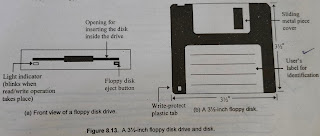Types of Magnetic Disks:
All magnetic disks are round platters. They come in different
sizes, use different types of packaging, and are made of a rigid metal or
flexible plastic. Based
on these differences, there are many types of magnetic disks available today.
Floppy Disks:
A floppy disk is a
flat, circular base or flexible plastic coated with magnetic oxide. It is encased in a square
plastic or vinyl jacket cover. The jacket gives handling protection to the
disk surface. Moreover, it has a special liner that provides a weeping action
to remove dust particles, as they are harmful to the disk surface and the
read/write head.
Floppy disks are so called because they are made of flexible plastic plates that can bend. They
are also known as a floppies or
diskettes. They were introduced
by IBM in 1972 and are now
produced in various sizes and capacities by many manufacturers.
Floppy Disk Drive:
A floppy disk drive is a device used to read/ write data
from/ to a floppy disk. It has a spindle to mount and rotate the disk, and
read/ write heads to read/write data to/from the disk. Unlike hard disk drives,
the read/write heads of a floppy disk
drive make direct contact with the disk surface during data
reading/ writing.
3 ½ inch Floppy Disk:
It is the most commonly used floppy disk. It consists of a 3 ½
inch diameter disk encased in a square, hard plastic jacket cover. The jacket
cover has a cut-out (aperture) for read/write head to make contact with disk
surface. This aperture is covered with a sliding metal piece.
When a floppy disk is inserted in a floppy disk drive for
use, the metal piece slides back to expose the disk’s surface to the drive’s
read write/head.
All 3 ½ inch floppy disks are of double-sided type that record data on both disk surfaces. However,
they come in three different capacities - double
density, high density, and very high density. The double density 3 ½ inch
diskettes have 40 tracks, 18 sectors/track, and 512 bytes/sector, giving
a total disk storage capacity of 2( for two surfaces) x 40 x 18 x 512 = 720 KB
(approx.). The high density 3 ½ inch
diskettes have 80 tracks, 36
sectors/track, and 512 bytes/sector, giving it total disk storage capacity of
2.88 MB (approx.).
Hard Disks:
Hard disks
are the primary online secondary storage device for most computer systems
today. They are made of rigid metal (aluminium) platters and come in many sizes
ranging from 1 to 14 inch diameter.
Types of Hard Disks:
Depending on
how they are packaged, hard disks are normally categorized into three types:
1. Zip/Bernoulli disk:
It consists of a single hard disk platter encased in a
plastic cartridge. The disk is commonly of 3 ½ inch size having storage
capacity of about 100 MB. The
storage capacity slightly varies depending on the formatting style used by a
computer system with which it is used. It’s disk drive, called zip drive, maybe of portable or a fixed
type. The fixed type is part of a
computer system permanently connected to it. The portable type can be brought and connected to a computer system
for the duration of use and can then be disconnected and taken away. A zip
disk can be easily loaded/unloaded into a zip drive just as we insert/ remove a
floppy disk drive or a video cassette in a VCR.
2. Disk Pack:
It consists of multiple (two or more) hard disk platters
mounted on a single central shaft. All the disks revolve together at the
same speed. Its disk drive has a separate
read/write head for each usable disk surface. Its disk drive is of
interchangeable type and allows loading/unloading of different disk packs as
and when they are to be used. When not in use, a disk pack is stored offline in
a plastic case. This gives virtually unlimited storage capacity to disk packs.
3. Winchester Disk:
A Winchester disk consists of multiple (two or more) hard
disk platters mounted on a single central shaft. However, unlike a disk
pack drive, a Winchester disk drive is of fixed type. Its hard disk
platters and a disk drive are sealed together in a contamination free container
and cannot be separated from each other. Hence, Winchester disk have limited capacity. However, for the same
number of disks platters of the same size, Winchester disk can have larger
storage capacity than disk packs due to following reasons:
- As both disk platters and disk
drive are permanently sealed together, all surfaces of all disk platters (including
the upper surface of the topmost platter and the lower surface of the
bottommost platter) are used for data recording in a Winchester disk.
- The contamination free
environment allows Winchester disks to employee greater precision of data
recording and accessing, resulting in greater data storage density than
interchangeable disk packs.
Winchester disks were so named after the 30-30 Winchester
rifle because the early Winchester disk systems had two 30MB disks. Storage capacity for today's
Winchester disks ranges from a few tens of megabytes to a few gigabyte.



No comments:
Post a Comment